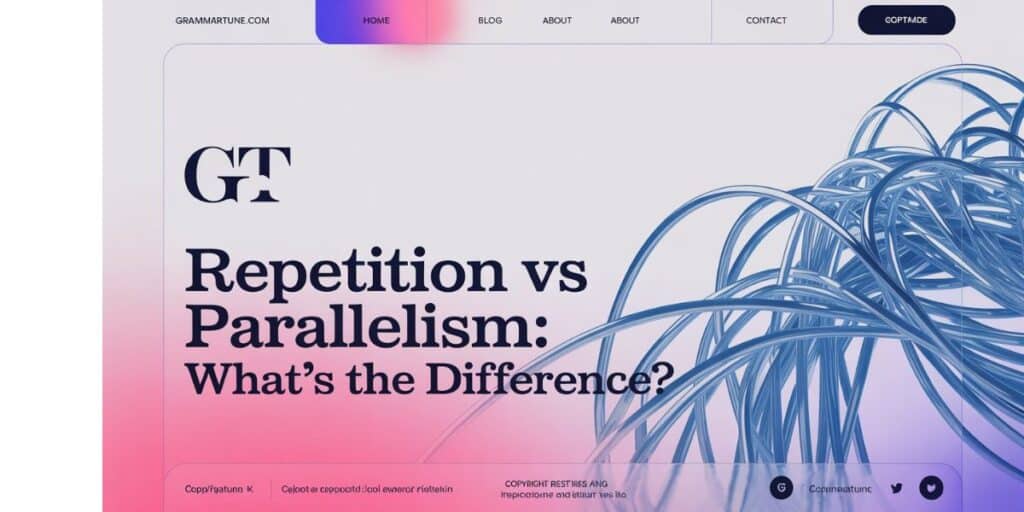Have you ever encountered some phrases that are very sticky? The influence of Repetition and the exactness of Parallelism are at play here. In this guide, we will understand the salient differences that distinguish the two potent tools of writing from one another.
Repetition
Repetition is the repeated word or phrase over and over again. This, however, serves well to make the point better. It becomes a deep stain on the memory of the reader.
Must read: Vicious vs Viscous: Use Them Correctly in Writing
Parallelism
Parallelism maintains the same grammatical structure in the parts of a sentence. It provides smooth writing and portrays a balance in it as well as clarity.
Repetition vs Parallelism: The Differences
Repetition is about saying the same thing again. Parallelism is about keeping the same form in writing. One repeats; the other matches style.
What is the Difference between Parallelism and Repetition in Poetry?
In poetry there can exist a kind of rhythmic emotion developed with repetition. Parallelism maintains the forward motion and equilibrium of lines. The two elements, however, add beauty in differing ways.
Is Parallel Structure Same as Repetition?
No, they are not the same. Parallel structure means similar form, not repeating words. Repetition brings back the same word or idea again.
Examples of Repetition
“I have a dream” is a famous repetition. It helps build emotion. The same line is used for power.
Examples of Parallelism
“She likes reading, writing, and jogging.” That’s parallelism. Each item follows the same form.
Examples Of Repetition and Parallelism
“I came, I saw, I conquered.” It’s both repetition in rhythm and parallel in structure. That’s why it feels strong and sharp.
Origins of Repetition and Parallelism
Both repetition and parallelism are ancient. They come from classical rhetoric. Used in speeches, poems, and stories.
Origins of Repetition
Repetition started in oral tradition. People repeated words to remember them. It was key before writing existed.
Origins of Parallelism
Parallelism comes from Greek and Latin writing. Writers used it for balance. It helped ideas feel equal and ordered.
How To Use Repetition and Parallelism In Sentences
Use repetition for emotion. Use parallelism for flow. Both improve clarity.
Using Repetition
Repeat key words or phrases. Do it for emphasis or rhythm. Don’t overdo it.
Using Parallelism
Keep word forms the same. Match verbs with verbs, nouns with nouns. This is clean and easy to follow.
Best Practices
Tips for Using Repetition and Parallelism Effectively
Keep it short and clear. Use repetition where feeling matters. Use parallelism to organize complex ideas.
Common Mistakes to Avoid
Too much repetition feels lazy. Bad parallelism sounds confusing. Make sure both are used with purpose.
You will like: What’s the Plural of Hippopotamus? Is it Hippopotamuses?
Context Matters
Choose wisely based on tone and goal. In formal writing, parallelism helps clarity. In creative work, repetition boosts drama.
Where not to use Repetition and Parallelism
Don’t force them. Avoid repetition if it adds no value. Skip parallelism if ideas don’t fit the same structure.
Definition and Basics
Parallelism Definition
Parallelism, the act of using the same structure for related words or phrases, adds clarity, balance, and fluidity to writing. It is quite a common practice in both writing and speech.
How to Pronounce Parallelism
Say it like this: PAIR-uh-lel-iz-um. Four parts, nice and steady. Make sure the “-ism” sounds like “-ism,” not “-um.”
Types and Contexts
Parallelism in Grammar vs. in Rhetoric and Literature
In grammar, parallelism keeps word forms the same. In rhetoric and literature, it’s about flow and power. The goal is different, but the tool is the same.
Parallelism in Grammar
This means using matching structures in a list or sentence. Example: “He likes to run, to jump, and to swim.” All the verbs match – that’s grammatical parallelism.
Parallelism in Rhetoric and Literature
Here, parallelism makes language sound stronger. Think of famous speeches or poetry that use repeated forms. It’s more about style and rhythm than rules.
Related Figures of Speech
Parallelism and Related Figures of Speech
Parallelism is often linked to other powerful tools. These include antithesis, anaphora, asyndeton, and epistrophe. They all help build strong, emotional writing.
Parallelism and Antithesis
Antithesis uses opposites in a parallel structure. Like “It was the best of times, it was the worst of times.” It’s clear and dramatic because of the parallelism.
Parallelism and Anaphora
Anaphora is a repetition of the same word at the beginning of a line. “We shall fight…we shall defend…we shall never surrender“. All three verbs share the parallel form, and it is this parallelism that empowers the utterance.
Parallelism and Asyndeton
There is leaving words that connect but retain structure within Asyndeton. I came, saw, conquered-there’s no “and,” and that’s what makes it so dynamic with those parallel verbs.
Parallelism and Epistrophe
The end of phrases marked by epistrophe repeats the same word. “See no evil, hear no evil, speak no evil.” This is a parallel structure with strong emphasis given by the repeated ending words.
You will like: Coach vs Couch: Definitions, Differences, and Examples
Conclusion
Their study also gave credence to the idea that Repetition vs Parallelism, if understood well in writing and speech, may alter or profoundly influence the potency of one’s message. Repetition signifies emphasizing a particular point by repeating a word or a phrase.
On the contrary, Parallelism may specify balance or lend rhythm through matching structures; having separate objectives, both techniques tend to interfere with the flow of a message, make it impactful, and make a certain message easier to retain.
When effectively applied, they become crucial in buttressing arguments, enriching the emotional appeal, and making a piece of writing persuasive. Whether in poetry or a speech, good use of Repetition vs Parallelism may enhance the connection between the transmitted message and the audience.
FAQ,S
What is parallelism in writing?
It’s using the same structure in related phrases to create flow and clarity.
Why is repetition used in speeches?
To emphasize ideas and make messages more memorable.
Is parallelism only for grammar?
No, it’s also used in literature and speeches for rhythm and impact.
Can repetition and parallelism work together?
Yes, many famous quotes use both for power and style.
What’s the risk of overusing them?
Too much can sound forced or boring—balance is key.

Joulia, a seasoned wordsmith and grammar enthusiast, brings over a decade of blogging expertise to Grammar Tune. With a keen eye for linguistic precision and a passion for making complex grammar concepts accessible, he has helped thousands of readers enhance their writing skills. His engaging teaching style and practical approach to language learning have made him a trusted voice in the online grammar community.







